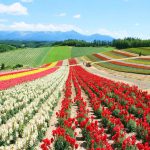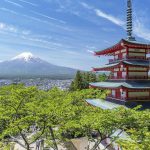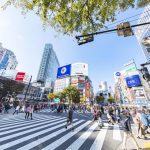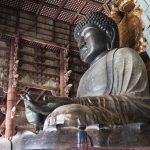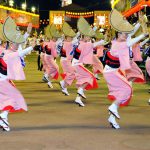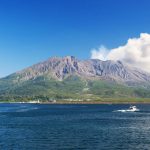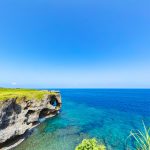Tohoku Region (Northern part of Honshu)
The Tohoku region, an area of about 400 km north-south and about 170 km east-west, is located in the northern part of Honshu and consists of six prefectures: Aomori, Iwate, Akita, Miyagi, Yamagata, and Fukushima. The climate varies considerably from north to south and east to west, offering a wide variety of attractions, such as its natural landscapes, historic buildings, hot springs, local festivals, and regional specialty foods.
Aomori
Located in the northernmost part of Honshu, Aomori’s untouched nature is its main attraction. Lake Towada, the largest caldera lake in Honshu, offers beautiful blue cliffs and virgin forests. Extending about 14 km from Lake Towada, the waters of the Oirase Gorge are known for their high transparency. Hiking in the deep natural forest is a highlight activity. Both Lake Towada and Oirase Gorge are famously known for the turning of the autumn colors.
The Shirakami Mountain Range is a registered World Natural Heritage Site, where the largest primeval beech forest in East Asia is found. It is popular with hikers from summer to autumn, and even beginners can enjoy walking around the 12 lakes, consisting of 33 large and small lakes, including the mystical Aoike.
Mt. Osorezan is located on the Shimokita Peninsula, that forms the northeastern part of Aomori Prefecture. It is one of the three major sacred sites in Japan, along with Mt. Koya and Mt. Hiei. There are Jizo statues and windmills in the desolate rocky area, where sulfuric fumes drift from the volcano. Further beyond, you will see the beautiful caldera Lake Usoriyama, popularly known as “Gokurakuhama” (paradise beach). There is also a temple called Bodaiji; a shukubo (lodging for pilgrims); and a hot spring.
The Nebuta Festival is one of Japan’s most spectacular summer evening festivals held in August throughout Aomori Prefecture. You will be impressed by this lively festival in which dancers perform to the musical accompaniment around the huge Nebuta lantern floats. Official Haneto dancer’s costumes are available for rent, so you can join in the festivities.
Iwate
Hiraizumi prospered as the 100-year capital of the Oshu Fujiwara clan in the 11th Century, at the end of the Heian period. Pure Land Buddhism, which was popular at the time, flourished here. Highlight attractions include: Chusonji Temple, Motsuji Temple, and the ruins of Kanjizaiōin, which are registered World Cultural Heritage Sites. Also recommended are: Chusonji Konjikido, lavishly covered in premium gold produced in Hiraizumi; and Motsuji Garden with its conceptual design based on the Buddhist Pure Land.
Iwate is abundant with natural beauty. Kitayamazaki offers a variety of magnificent coasts with cliffs and mysterious rocks that have been washed by the rough waves of the Pacific Ocean. Jodogahama Beach has beautiful white sands and blue waters. Ryusendo is a limestone cave with a crystalline underground lake. You can also enjoy a slow boat ride through the deep mountains and valleys, and enjoy the autumn foliage in Geibikei.
Akita
Kakunodate, a castle town that prospered during the Edo period, will transport you back in time. You will find black fences and gates that retain the remnants of those olden days, when samurai residences and old brewery warehouses lined the town. During the spring cherry blossom season from late April to early May, about 450 weeping cherry trees bloom in a beautiful row along Bukeyashiki (samurai residences) Street.
Nyuto Onsen, dotted with seven charming inns in a mountainous region surrounded by beech forests, is one of Japan’s best kept hot springs secrets. At Tsuru no Yu, the oldest hot spring in Nyuto, you will be impressed by the thatched-roof quarters in which the samurai stayed during the Edo period. The famous milky white water springs up from the gravel at the bottom of the open-air bath.
At the Akita Kanto Festival, held in midsummer from August 3rd to 6th, approximately 280 poles strung with lanterns and 10,000 candles color the Akita night. It is a wonder to watch the heavy lantern poles being balanced in the palm of a hand, on the forehead, and hips. The pleasant sounds of the music will make you want to experience this festival forever.
Miyagi
Matsushima’s deeply indented coastline was formed by the submerging peninsula, and is one of the three most scenic spots in Japan, with beautiful views of 260 large and small islands covered with pine trees and surrounded by the blue sea. Cruises around Matsushima are popular. Another famous attraction is Zuiganji Temple, the Family Temple of Date Masamune, a military commander from the Warring States to the Edo period, and an important historical figure. You can also enjoy fresh local gourmet seafood, such as oysters and conger eels.
In Sendai, the largest city in Tohoku, you can enjoy visiting Sendai Castle, museums, and sampling gourmet food. It is highly recommended that you visit Zuihoden, the vividly colorful mausoleum of Date Masamune.
Miyagi offers a variety of seafood items such as mackerel pike, bonito, tuna, and oysters from the local shores of Ishinomaki, Shiogama, Onagawa, and Kesennuma. Japan’s premium Sasanishiki rice; beef tongue; zunda (green soybean) mochi; and prime-quality Japanese Sendai beef are also well-known specialty products from this area.
Yamagata
Hojusan Risshakuji, popularly known as “Yamadera” (mountain temple), is a mysterious temple built on a steep mountain surface. From the foot of the mountain, you can reach Okunoin by climbing 1,015 steps. On the way, experience the stunning view from Godaido, where you can enjoy the everchanging beauty of the four seasons, such as the autumn foliage.
Dewa Sanzan (three mountains of Dewa) consists of Mt. Haguro, Mt. Gassan and Mt. Yudono, and is a sacred place for mountain worship. Many pilgrims still visit these mountains. A shrine has been erected at the summit of each of the sacred mountains. From the foot to the summit of Mt. Haguro, you must climb the 2,446 steps that continue for 2km through a cedar forest. Along the way are two mysterious sites not to be missed: the five-story pagoda, which is a national treasure; and Jijisugi, a 1,000-year-old sacred tree.
Ginzan Onsen is a hot springs resort aligned with wood-crafted inns illuminated by gas lamps, creating a magical atmosphere.
In Yamagata, you can enjoy gourmet foods, such as Yonezawa beef, the finest Japanese beef brand; Imoni, a local meat and vegetable soup dish; cherries (most of Japan’s cherries are produced in Yamagata); and Dadacha-mame (a variety of green soybeans) that you won’t be able to stop eating, once you start.
Fukushima
In Ouchi-juku, a post town that prospered during the Edo period, you can experience a rare sight: approximately 40 private houses with thatched roofs, lining both sides of a 500m straight road. While strolling, you will feel as though you have slipped back in time and become a samurai. Misawaya’s green onion soba is a local favorite, and can be eaten with a single long onion.
Many historic sites are located in Aizuwakamatsu, known as the battleground of the Boshin War. Tsuruga Castle, with its beautiful red roof tiles and five-story tower, is an important symbol of Aizuwakamatsu.
Kitakata is a brewery town with over 400 warehouses that prospered during the Edo period; it is famous for its local ramen.
Higashiyama Onsen prospered as a hot springs resort during the Edo period, and was loved by literary scholars of the Meiji era; it is lined with more than 20 hot spring inns along the Yukawa river. Mukaitaki, a long-established inn revered for its grand ambience, was constructed in a splendid Japanese architectural style known as Sukiya-zukuri.


